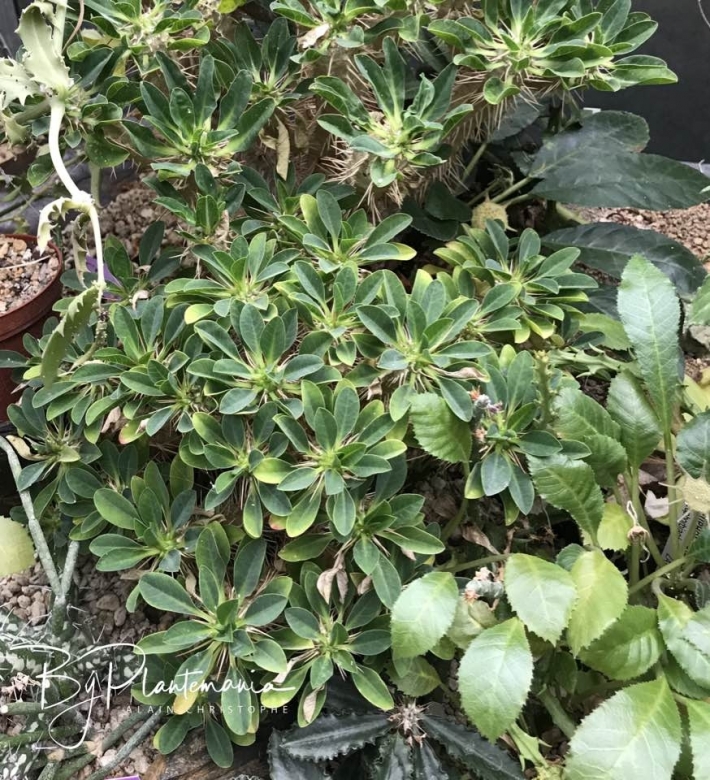
Euphorbia guillauminiana Photo by: © Plantemania
10 years old from seed.
Origin and Habitat: Euphorbia guillauminianaSN|34778]]SN|34778]] is endemic to the District of Analalava (Ambarijeby, Boriziny): Port-Bergé area in Westerm Madagascar. This species has a small area of occupancy (96.1 km²).
Habitat and ecology: This species grows on basalt rocks. It is threatened by habitat degradation and human activity, as well as by illegal collection for the horticultural trade.
Synonyms:
Description: Euphorbia guillauminianaSN|34778]]SN|34778]] is a densely branched, hemispherical, succulent-stemmed shrub, up to 60(-100) m high, wit thick, branches with spines arranged in 8 rows, numerous towards the apex. The leaves are crowded at the apices of the stems. The flowers are yellow or red.
Stem: Trunk thick, branching at 10 cm high, rebranching at intervals in 3 to5 smaller
branchlets; branches are numerous thick, horizontally spreading, grey, cylindrical 1-1.5 cm in diameter.
Leaves: Sessile or short petioled, rosulately crowded at branches tips, ovate, to 2 cm long, and 1 cm broad, dark green, glabrous, glossy, with a definite central rib, leaf margin pink or white. Petiole to 8 mm long, thick. Deciduous.
Stipular spines: 2-4 at each node, numerous towards the apex in 6-8 rows, slightly spreading, 12-30 mm long, base expanded, grey with age, deciduous.
Inflorescences. Cymes at branches tips, 1- to 2-forked, subsessile, peduncles short, with 2 to 4 cyathia, these erect. Cyathophylls (leaf-like bracts surronding the flowers) erect, completely enclosing the cyathium, yellowish green or yellow, rarely red, enveloping the ciathia.
***Flowers (Ciathia): ca. 2.5 mm in diameter, hairy. Nectar-gland yellowish. Ovary hairy.
Bibliography: Major references and further lectures
1) Hermann Jacobsen, "Abromeitiella to Euphorbia", Blandford Press, 1960
2) Hermann Jacobsen, "A Handbook of Succulent Plants: Descriptions, Synonyms, and Cultural Details for Succulents Other Than Cactaceae", Volume 1, Blandford Press, 1960
3) Urs Eggli, "Illustrated Handbook of Succulent Plants: Dicotyledons", Volume 2. Springer, 2002
4) Haevermans, T. 2004. Euphorbia guillauminiana. The IUCN Red List of Threatened Species 2004: e.T44357A10895639. http://dx.doi.org/10.2305/IUCN.UK.2004.RLTS.T44357A10895639.en. Downloaded on 19 November 2017.
5) Walter Minuth, Rikus van Veldhuisen & Volker Buddensiek, "Euphorbias from A – Z", Vol. 7 n. 1 - April 2011(pp.27-27)
Cultivation and Propagation: Euphorbia guillauminianaSN|34778]]SN|34778]] is quite difficult to cultivate, and extremely sensitive to watering while dormant. Best kept by continuously growing new seedlings to replace losses.










